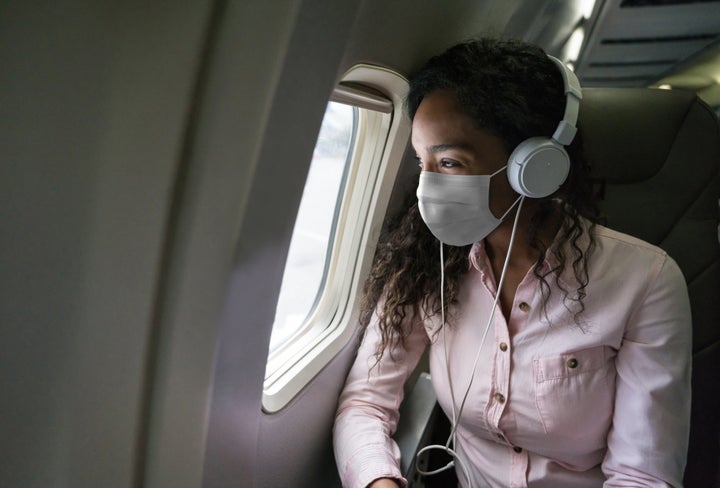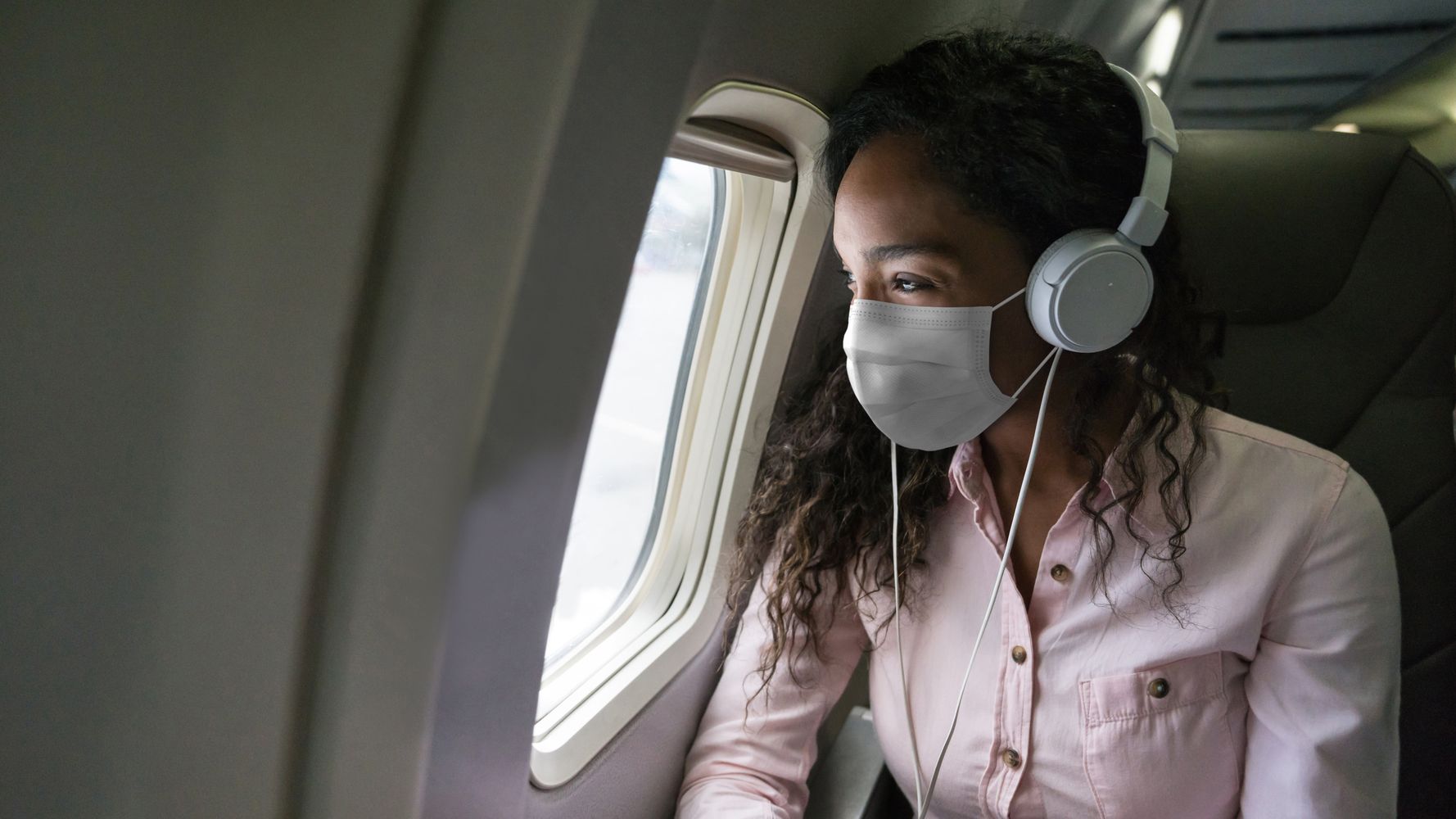
If you feel like people are getting more comfortable with air travel at this stage of the COVID-19 pandemic, your hunch is correct.
Since March 11, the Transportation Security Administration has screened more than 1 million passengers every day. On May 2, that number exceeded 1.6 million for the first time since March 12, 2020.
But as people ease back into flying, there are still lingering questions about the risk involved in spending time on an airplane, especially now that airlines have ended their middle seat blocking policies. For the most nervous fliers, there’s a desire to assert control by choosing to sit in the “safest” part of the plane from a COVID-19 transmission perspective. But is there such thing?
HuffPost asked health and travel experts to break down the safety of flying right now and how to choose a plane seat with minimal risk.
The risk of air travel is considered relatively low
“Traveling on a plane does put you at risk for COVID exposure, but it is considered a lower risk,” said Dr. Cristina M. Amado, an infectious disease physician with Orlando Health Infectious Disease Group. “That is because of the safety checks and sanitation measures that airlines have developed. Crew members perform deep cleaning in between flights. Passengers are required to wear masks on flights. The risk of viral transmission on a flight is low due to the way air circulates and filters on an airplane.”
Airplanes generally have HEPA (high efficiency particulate air) filters that circulate a mix of fresh and recycled air and minimize exposure to contagious droplets.
“There have been almost no superspreader events on planes compared to other indoor events,” said Scott Keyes, author of “Take More Vacations” and founder of Scott’s Cheap Flights. “The HEPA filters are constantly refreshing the air, everyone is required to wear a mask and face the same direction, and people are generally quiet, not shouting or singing, so it’s safer for COVID.”
He added that the time when the plane is on the ground might be a bit riskier, though still relatively low risk with masks, vaccinations and distancing.
“When planes aren’t in the air, that same filtration system isn’t necessarily running, so you may not have the same level of air circulation the way you do during the flight,” Keyes said, noting that this can vary based on the airline and individual aircraft. “I believe United is one airline that has taken the step of running it with their auxiliary power unit during the boarding and deplaning process to minimize the transmission risk.”
Most experts believe the bigger COVID-19 risk in air travel comes from the time before you even board the plane thanks to things such as dining at airport restaurants, queuing to board, and waiting on a crowded jet bridge.
“The flight itself is low risk if you remain seated throughout,” said Dr. Sachin Nagrani, a physician and medical director for the telemedicine and house call provider Heal. “Airplane travel introduces risk of contracting COVID primarily from spending time in security lines, at the gates, and while boarding and deplaning when you are near other people indoors.”
Window seats may carry the lowest risk
Some airlines responded to the COVID-19 pandemic by keeping all middle seats empty on their flights.
“Studies done on keeping the middle seat open have shown decreased virus exposure by 23 to 57%,” Amado said. “However, these studies were not done on masked passengers.”
As of May 1, Delta is no longer blocking its middle seats ― the last major U.S. carrier to end this practice. So if you’re trying to reduce risk as much as possible, consider booking the least full flight you can find. The specific seat you choose may also make a small difference.
“The window seat might be the safest place to sit compared to an aisle seat, as you do not have other passengers walking past you,” Amado said. “Also, choosing a seat in the back of the plane may be safer than the front, as again, you would have less passengers walking by.”
Nagrani echoed that advice, noting, “The window seat is the safest option due to the direction of airflow within the cabin.”
The most or least desirable seats each have benefits
Another way to potentially reduce risk could be splurging or cashing in your points for a seat in the smaller, more spaced-out business class cabin.
“Now is the time to use up all those points you racked up in 2020 for a business class upgrade,” said Konrad Waliszewski, co-founder and CEO of the travel app Tripscout. “You should be sipping free Champagne on your next flight ― but in the name of health and safety!”
If that isn’t an option for you, however, he suggested choosing the “least desirable” window or aisle seat on the plane.
“This will increase the chance you won’t have someone sitting right next to you,” he said. “Pick a seat in the very back of the plane, but avoid picking a seat too close to the restroom in order to avoid crowds congregating. The back is also safer because you are less likely to have every passenger walking past your seat during boarding.”
Still, there’s no need to worry if your seating options are limited. Air travel, especially given the continued mask mandates, still carries relatively little risk compared with other indoor activities.
“Window seats may carry a lower risk to getting exposed,” said Dr. Andrés Henao, an internal medicine physician, infectious disease specialist, and director of the UCHealth Travel Clinic. “However, the risk overall is low.”
Other safety precautions are important
Being mindful about your seat choice isn’t the only ― or even the most important ― way to protect your health when taking a flight.
“The recommendation is to get fully vaccinated if at all possible before traveling by air,” Henao said. “Keep wearing a mask, wash hands and practice social distancing.”
Airlines and airports are still requiring masks for vaccinated and unvaccinated travelers alike ― a rule many believe will remain in place longer than other restrictions.
“Wear a mask, preferably surgical grade or N95, and consider using a cloth mask over the medical mask to ensure a good seal around the edges,” Nagrani advised. “Make efforts to distance from others; for example, by limiting carry-on baggage, checking in online, and avoiding crowding into a line while boarding or deplaning.”
Amado emphasized the importance of washing and sanitizing hands when touching airplane surfaces and trying not to eat or drink during your flight.
“If you choose to eat or drink during the flight, you should remember to put your mask back on in between sips and bites,” she said. “Try not to get up and walk around too much while on the flight.”
She also advised minimizing your time in airports and on planes by choosing flight options with the fewest layovers.
“Try to avoid crowds as much as possible while waiting in the airport for your flight,” she said. “Also, if you feel sick, you should reschedule your flight. Many airlines are not charging change fees right now. It is better to be safe than risk getting or spreading COVID-19.”
